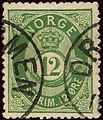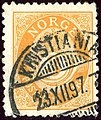The posthorn issues of Norway
The posthorns of Norway are famous for having been printed during at least 100 years (1878-1978) with limited modifications.
First issue 1872-1875
[edit]6 values in skilling (1 to 7 sk). NORGE in Grotesk (Egyptian capitals) characters. Note the possible use during the öre currency after 1877 (valid until 1908!).
Designed by: Wilhelm von Hanno (1826-1882), Engraved by: Phil. Batz Print Process: Typo by P. Petersen.
Catalogue N°s Michel 16-21, Yvert 16-21, SG (1955) 31-44 with shades.
-
1 sk unused
-
1 sk late use in 1897
-
2 sk blue
-
3 sk Antiqua cancel
-
3 sk Grotsek cancel
-
4 sk violet
-
6 sk
-
7 sk
Second issue 1877-1878, 1879 (5 öre re-engraved), 1882 (10 öre re-engraved)
[edit]Posthorn shaded, first Norway issue in öre (1/3 skilling) currency on 1 January 1877. Sub-issue on 1 October 1878. 10 values (1 to 60 öre). Catalogue N°s Michel 22-31, Yvert 22-31, SG (1955) 46-67 with shades. Two values later re-engraved: 5 öre with small "5" without ball on foot; 10 öre with large "1" numeral with tip pointing downward.
-
1 öre unused
-
3 öre
-
3 öre
-
5 öre
-
5 öre
-
10 öre
-
12 öre
-
20 öre
-
20 öre
-
25 öre violet
-
35 öre
-
50 öre
-
60 öre
Third issue 1882-1893
[edit]Third posthorn issue, öre currency, posthorn not shaded. Two sizes (21 mm 1882-1885; and 20 mm 1886-1893). Multiple printings and plate settings, particularly with the 3, 5, 10, and 20 values. Catalogue Michel N°s 35-51; SG (1955) 71-107 with shades.
-
1 öre 20 mm Plate I 1891 issue
-
1 öre 20 mm Plate I 1891 issue
-
1 öre 1893 20 mm Plate II issue (plus 5 öre next issue)
-
2 öre 1888 surcharge
-
2 öre Org-brown 1890 issue
-
3 öre orange
-
5 öre green
-
10 öre red 20 mm (Plate III)
-
12 öre 21 mm green rare
-
12 öre 21 mm brown
-
20 öre ultramarine 21 mm
-
20 öre dull blue to light ultra. 20 mm (Plate II)
-
25 öre 20 mm
First issue NORGE in Antiqua, 1893-1905
[edit]Engraved by Trondsen. Typo printed by Central Printing Works (1893-1895) and Chr. H. Knudsen (1895-1908). Catalogue N°s Michel 52-61; Yvert 46-57; SG (1955) 121-130 with shades.
There are 2 perforations: 14²:13² (1893-1894; 1898-1908) or 13²:12² (1894-1898). Some of the Central Printing issues (3 and 20 öre) from 1893/94 were perforated 13²:12² when the perforation machine gauged 14²:13² was broken or undergoing repairs. Misaligned perforations on stamps 13²:12² are common and are due to bent or misaligned pins.
-
1 öre grey
-
2 öre (Knudsen) Mi53
-
2 öre (Knudsen) Mi53
-
3 öre (Central) Mi54B
-
5 öre
-
10 öre carmine Mi56a
-
20 öre ultramarine
-
25 öre perf 14²:13² (Knudsen) Mi58A
-
25 öre (Knudsen) Mi58
-
35 öre perf 13²:12² (Knudsen) Mi59B
-
50 öre (Knudsen) Mi60
-
60 öre deep blue
1908 sub-issue
[edit]-
15 öre red-brown (Knudsen), DC at BERGEN, Mi71
Second issue NORGE in Antiqua, 1909-1919, 1920-1929
[edit]
New design by Hellik Rui (1871-1939). Typo printed by Chr. H. Knudsen (1 to 60 öre). Additional new values and new colours (5 to 40 öre) issued from 1920-1929. Some values printed until June 1937. The 30 öre exists in grey (1910-1925) and slate (May 1926); the 60 öre exists in dark blue (1910-1921) and light greenish blue (1924-1926). This issue is easy to identify as the shading inside the posthorn ring below the crown has been removed and replaced by a faint diagonal line; the small numerals in the oval band are of one type with a bold somewhat rounded font.
Catalogue Michel N°s 75-88.
-
5 öre green Mi78
-
15 öre, DC at Molde on 22 May 1912, Mi81.
-
20 öre ultramarine unused Mi82
-
30 öre, DC at AA on 8 July 1915, Mi84.
-
50 öre, DC at Fjøsanger, Mi87.








































